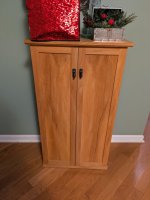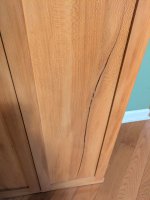Beautiful paddles Patrick.
Looks like a nice set of curve templates too.
Jim
Looks like a nice set of curve templates too.
Jim


I am in the process of making a bow out of Osage. The yellow is quite vibrant. The wood will darken over time and eventually become a dark brown. I’m curious to see how this paddle turns out.The Osage Orange is looking intriguing. Not wide enough for a single board paddle and besides, there's very little straight grain. When splitting to make it manageable for the bandsaw it curved significantly as shown here. However, that curved grain will match the curve of a paddle blade nicely in a book match arrangement.
View attachment 144413
Look at the color of the sawdust!View attachment 144414
Glenn, to answer your earlier question... I just use my phone- a relatively old iPhone 8. Results are hit or miss frankly. Sometimes focus is not so good, other times outstanding. I don't know why..






Thanks for your compliment! Don't forget, it's the quarter sawn Sycamore that exhibits that figure when you cut across the medullary rays. I don't have any flat sawn Sycamore to compare the figure with, so I don't know how that would look.So I'll be curious to see if you can get anything usable from the osage orange log.



Years ago I bought a pile of sycamore and used the flat sawn and knotty stuff to make shop cabinets. The grain is kind of interesting, but looks nothing like the quartersawn stuff. Below is a picture. The stiles & rails are flatsawn sycamore and the panels are red oak. Unfortunately they warped horribly. The sawyer always did a great job drying (mostly air drying) and out of thousands of board feet I bought from him this is the only stuff that ever warped. I can't blame it on the wood species since it's the only sycamore I ever bought. Could have just been a tree with a lot of internal stresses.Thanks for your compliment! Don't forget, it's the quarter sawn Sycamore that exhibits that figure when you cut across the medullary rays. I don't have any flat sawn Sycamore to compare the figure with, so I don't know how that would look.

it's the quarter sawn Sycamore that exhibits that figure when you cut across the medullary rays. I don't have any flat sawn Sycamore to compare the figure with, so I don't know how that would look.
Unfortunately they warped horribly. The sawyer always did a great job drying (mostly air drying) and out of thousands of board feet I bought from him this is the only stuff that ever warped. I can't blame it on the wood species since it's the only sycamore I ever bought. Could have just been a tree with a lot of internal stresses.


Yes, back at that time I'd check everything with a meter unless it had been in my shop for a long time. I think maybe the stiles and rails warped and locked the panel so it couldn't float with seasonal moisture changes. Or maybe there was just a lot of stress in that board.That almost looks like a shrinkage split ... did you have a moisture content measurement at the start?
